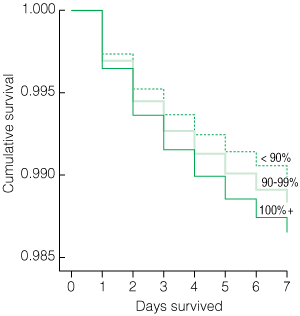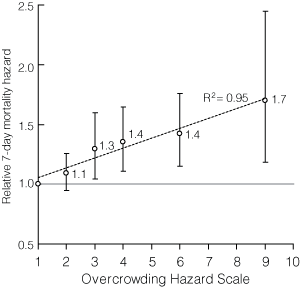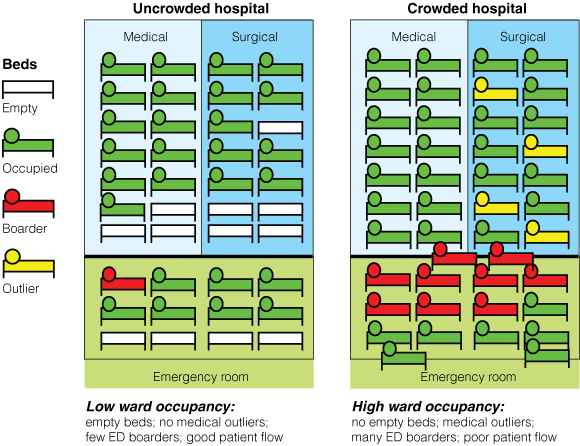Emergency department (ED) overcrowding is common in North America, the United Kingdom and Australasia.1-3 Overcrowding results in ambulance diversion and impaired ED responsiveness.2,4,5
Inpatient bed “access block” is the principal cause of ED overcrowding.1,4,6 Access block is defined as the proportion of ED patients requiring admission whose total time within the ED exceeds 8 hours.7 Access block is correlated with total hospital inpatient bed occupancy of 90% or more, as measured by a midnight bed census.7-9 A target occupancy of 85% has been suggested as a balance between unused bed capacity and efficient inpatient flow.8,10
Some studies have identified a relationship between high occupancy, access block and adverse patient outcomes, as measured by inpatient length of stay, hospital readmission or reattendance for emergency care.11-13
Western Australia’s population at 30 June 2001 was 1.9 million, with 1.4 million people (77%) residing in metropolitan Perth.14 Perth has seven public and three private hospitals with EDs. The Emergency Care, Hospitalisation and Outcome Study Project (ECHO) links all metropolitan Perth’s emergency care records, with sufficient information to allow linkage, to metropolitan prehospital care records and hospitalisation and mortality records for the whole state.
Death records were obtained from the Western Australian Mortality Database. The records contain death certificate information, including date of death and principal and secondary causes of death.15
EDIS, the Hospital Morbidity Data System, and the Mortality Database records were linked by the Western Australian Data Linkage Unit using probabilistic matching.15,16 EDIS records for the period 1 July 2000 to 30 June 2003 were linked to morbidity and mortality records until 31 March 2004. A minimum of 42 000 records were needed to identify a 30-day mortality hazard ratio of 1.2 with a power of 0.9.
Our analysis examined the effect on mortality of overcrowding, as indicated by high hospital occupancy and high ED occupancy of patients waiting for an inpatient bed. Box 1 illustrates the difference between uncrowded and overcrowded conditions.
Hospital occupancy was calculated from the admitted patient census at 23:59 on the day of attendance, divided by the 99th centile 23:59 patient census for the hospital during the first 6 months of the calendar year (eg, 400/500 = 80%). Access block occupancy was calculated as the percentage of ED cubicles occupied by patients experiencing access block (ie, waiting 8 hours or more for an inpatient bed) at the time of emergency attendance. The relationship between hospital occupancy, access block occupancy and other risk factors hypothesised as likely to influence mortality by Day 2 (Day 1 = day of attendance), Day 7 and Day 30 were evaluated using Cox regression analysis. Risk factors other than those indicative of hospital or ED occupancy or flow were chosen on the basis of a known relationship with emergency admission deaths, cost or hospital length of stay.11,17 The model for the effect of overcrowding on mortality was developed manually. Deaths associated with overcrowding were calculated as the excess deaths in the exposed population.
Two potential confounders were tested.
Confounding due to increased respiratory and cardiovascular diagnoses in winter was tested by removing admissions in the four peak respiratory/influenza months (June–September) of each year from the models.
Confounding caused by admission selection (ie, hospitals operating at high occupancy may be less likely to admit patients at lower risk of death, resulting in a spurious association between overcrowding and mortality) was tested by assessing the relationship between overcrowding and the probability of admission for all adult index emergency attendances to the hospitals using binary logistic regression.
There were 62 495 first emergency admissions and 3084 deaths by the Day 30 censoring date. The admission characteristics, grouped by hospital occupancy, are summarised in Box 2. Higher hospital occupancy was associated with a slightly higher proportion of elderly, female, illness admissions, and was more likely during weekdays and during winter. However, the hospital occupancy groupings were undifferentiated with respect to the proportion of physician-referred admissions, ambulance-transported admissions, triage urgency, or length of hospital stay.18
Box 2 shows a positive relationship between level of hospital occupancy and death by days 2, 7 and 30 after index ED attendance, with a relative increase in mortality by Day 7 of 18% (95% CI, 0.5%–38%) for hospital occupancy of 90%–99% and 46% (95% CI, 14%–85%) for hospital occupancy of 100% or more.
Box 3 illustrates the 7-day survival stratified by hospital occupancy, adjusted for age, mode of transport, diagnosis (ICD-10-CM), triage urgency and referral source. In comparison with < 90% occupancy, the 7-day hazard ratio for 90%–99% hospital occupancy was 1.2 (95% CI, 1.1–1.3; P = 0.02), and for ≥ 100% hospital occupancy it was 1.3 (95% CI, 1.1–1.6; P = 0.001). Initially significant univariate associations between mortality and winter season, month of year, individual day of week and time of day were rendered non-significant after adjustment for the above variables. Adjustment for hospital attended (including use of an interaction term “hospital × occupancy”) or length of hospital stay did not significantly change the hazard associated with hospital occupancy.
Box 4 presents the 7-day hazard ratios associated with the Overcrowding Hazard Scale, using an identical model to that used for Box 3, but with the Overcrowding Hazard Scale substituted for hospital occupancy. A linear relationship between the Overcrowding Hazard Scale and 7-day mortality hazard was demonstrated (r = 0.98; 95% CI, 0.79–1.00; P = 0.001), indicating that an Overcrowding Hazard Scale score > 2 (defining “overcrowded conditions”) is associated with increased patient mortality.
Box 5 presents the hazard ratios associated with overcrowded conditions and the other factors associated with Day 7 deaths, and Box 6 presents the deaths associated with overcrowded conditions, censoring survival at 2, 7 and 30 days: 2.3 deaths per 1000 emergency admissions were associated with overcrowded conditions by Day 30 (95% CI, 1.2–3.2), or an estimated 120 deaths (95% CI, 60–170) among the 53 025 tertiary hospital emergency admissions (including non-index admissions) in Perth in 2003.
Testing for winter seasonal confounding revealed no significant effect. The Day 7 hazard ratio for overcrowded conditions after exclusion of 22 582 June to September admissions (36.1%) (hazard ratio, 1.3; 95% CI, 1.1–1.5; P = 0.002) was essentially identical to the Day 7 hazard ratio for the total study population in overcrowded conditions reported in Box 5.
Deaths by Day 30 associated with overcrowded conditions were undifferentiated with respect to age, diagnosis, urgency, mode of transport, referral source or hospital length of stay compared with uncrowded conditions. However, patients dying who experienced overcrowded conditions were more likely to be male (risk ratio, 1.3; 95% CI, 1.1–1.5; P = 0.007) and to have attended during winter (risk ratio, 2.9; 95% CI, 2.4–3.5; P < 0.001), between Monday and Friday (risk ratio, 2.1; 95% CI, 1.7–2.6; P < 0.001) and between 08:00 and 15:59 (risk ratio, 1.7; 95% CI, 1.3–2.2; P < 0.001), consistent with the known weekly and seasonal variation in hospital overcrowding and ambulance diversion in metropolitan Perth (see Box 2). Patients dying who experienced overcrowded conditions had longer total durations of stay in the ED (risk ratio per hour of ED stay, 1.1; 95% CI, 1.1–1.1; P < 0.001) and slightly longer physician waiting times (risk ratio per hour of ED wait, 1.2; 95% CI, 1.1–1.3; P = 0.01).
The finding of increased mortality associated with overcrowding is consistent with the known effects of overcrowding on emergency hospital admissions. Hospital occupancy above 90% has been demonstrated in our study to be closely associated with ED access block and is associated with an increased duration of ED stay.9 The duration of stay in the ED was longer for patients who experienced overcrowded conditions and died.
Our study did not examine the mechanisms by which overcrowding is associated with increased mortality. Examination of delays in the initiation of time-critical care, such as the administration of antibiotics in sepsis, may be a fruitful line of enquiry.19 The longer physician waiting times and ED durations of stay among patients in our study who experienced overcrowded conditions and died may be acting as proxies for delays in the initiation of care. The presence of patients experiencing access block is strongly correlated with longer physician waiting times in EDs in both metropolitan Perth (r = 0.86) and internationally.4,6
Human error theory predicts that errors occur more often when systems are stressed by constraining resources; such as when a hospital is overcrowded.20 Overcrowding is often associated with placing inpatients on an incorrect ward (eg, medical patients placed on surgical wards) where staff may be less familiar with standard service guidelines for care of the patient’s condition or the clinical cues associated with potential adverse events. Such patient “outlying” may be a mediator of the association between overcrowding and increased mortality.
Given the association between the Overcrowding Hazard Scale and increased mortality, we suggest that the scale could be used to monitor the hazard associated with overcrowding in real-time. An Overcrowding Hazard Scale score > 2 may be considered prima facie evidence of an increased Day 7 mortality hazard.8
Hospital overcrowding is a complex phenomenon. The prevalence of overcrowding may rise in health services in developed economies as age-related demand for hospital services grows over the next 10–15 years.21 In addition, economic incentives tend to favour high occupancy.21 Solutions may include the realignment of incentives that favour high levels of hospital occupancy at the expense of emergency access. Other solutions may include strategies that reduce waste, misuse and overuse of health services, and improved chronic disease management to reduce hospital bed demand.22 In addition, better matching of bed supply with predictable emergency demand and optimisation of hospital inpatient flow are required.22-24
3 Seven-day survival* after emergency admission stratified by hospital occupancy on the day of admission

* Adjusted for age, mode of transport, diagnosis (ICD-10-CM), triage urgency, and referral source.
4 Relationship between the Overcrowding Hazard Scale and the 7-day mortality hazard for emergency admissions

5 Hazard ratios for variables used in 7-day mortality Overcrowding Hazard Scale model
Australasian Triage Scale urgency Category 1 (resuscitation v less urgent categories 3, 4, 5)18 |
|||||||||||||||
Australasian Triage Scale Category 2 (emergency v less urgent categories 3, 4, 5)18 |
|||||||||||||||
Received 24 May 2005, accepted 21 November 2005
- Peter C Sprivulis1
- Julie-Ann Da Silva2
- Ian G Jacobs3
- George A Jelinek4
- Amanda R L Frazer5
- 1 Department of Emergency Medicine, University of Western Australia, Perth, WA.
- 2 Women and Children’s Health Service, Subiaco, WA.
Peter Sprivulis acknowledges the support of the Commonwealth Fund, New York, during preparation of this manuscript. The views presented are those of the authors and not necessarily those of the Fund.
We thank Dr David Bates, Dr Michael Schull, Dr Chaim Bell, Dr Stephen Schoenbaum and Dr Donald Goldmann for comments on an earlier version of this manuscript.
The Emergency Care, Hospitalisation and Outcome Study (ECHO) is supported by the Australian Health Ministers’ Advisory Council Priority Driven Research Funding Program. The ECHO Investigators are: Neil Banham, Simon Wood, Judith Finn, Gary Geelhoed, Adrian Goudie, Tom Hitchcock, Jack Hodge, Andrew Jan, Michelle Johnston, Debra O’Brien, Alan O’Connor, Paul Mark, David Mountain, Yusuf Nagree, Greg Sweetman, and Garry Wilkes. ECHO acknowledges the staff of Perth’s emergency departments, the St John Ambulance Service, and the WA Data Linkage Unit.
None identified.
- 1. Fatovich DM, Hirsch RL. Entry overload, emergency department overcrowding, and ambulance bypass. Emerg Med J 2003; 20: 406-409.
- 2. Schneider SM, Gallery ME, Schafermeyer R, Zwemer F. Emergency department crowding: a point in time. Ann Emerg Med 2003; 42: 167-172.
- 3. Vilke GM, Brown L, Skogland P, et al. Approach to decreasing emergency department ambulance diversion hours. J Emerg Med 2004; 26: 189-192.
- 4. Schull MJ, Lazier K, Vermeulen M, et al. Emergency department contributors to ambulance diversion: a quantitative analysis. Ann Emerg Med 2003; 41: 467-476.
- 5. Glaser CA, Gilliam S, Thompson WW, et al. Medical care capacity for influenza outbreaks, Los Angeles. Emerg Infect Dis 2002; 8: 569-574.
- 6. Fatovich DM, Nagree Y, Sprivulis P. Access block causes emergency department overcrowding and ambulance diversion in Perth, Western Australia. Emerg Med J 2005; 22: 351-354.
- 7. Australasian College for Emergency Medicine. Access block and overcrowding in emergency departments. Melbourne: ACEM, 2004.
- 8. Bagust A, Place M, Posnett JW. Dynamics of bed use in accommodating emergency admissions: stochastic simulation model. BMJ 1999; 319: 155-158.
- 9. Forster AJ, Stiell I, Wells G, et al. The effect of hospital occupancy on emergency department length of stay and patient disposition. Acad Emerg Med 2003; 10: 127-133.
- 10. Green LV. How many hospital beds? Inquiry 2002-2003; 39 (4): 400-412.
- 11. Richardson DB. The access-block effect: relationship between delay to reaching an inpatient bed and inpatient length of stay. Med J Aust 2002; 177: 492-495. <MJA full text>
- 12. Miro O, Antonio MT, Jimenez S, et al. Decreased health care quality associated with emergency department overcrowding. Eur J Emerg Med 1999; 6: 105-107.
- 13. Liew D, Liew D, Kennedy MP. Emergency department length of stay independently predicts excess inpatient length of stay. Med J Aust 2003; 179: 524-526. <MJA full text>
- 14. Health Information Centre. Population characteristics of residents of the Perth metropolitan health region. Perth: Western Australian Department of Health; 2001.
- 15. Holman CDJ, Bass AJ, Rouse IL, Hobbs MST. Population-based linkage of health records in Western Australia: development of a health services research linked database. Aust N Z J Public Health 1999; 23: 453-459.
- 16. Jaro MA. Probabilistic linkage of large public health data files. Stat Med 1995; 14: 491-498.
- 17. Coopers & Lybrand Consultants. Outpatient Costing and Classification Study incorporating the Developmental Ambulatory Classification System Evaluation. Report for the Commonwealth Department of Health and Family Services, Canberra. Adelaide: Coopers & Lybrand Consultants, 1998.
- 18. Australasian College for Emergency Medicine. Policy Document — The Australasian Triage Scale. Melbourne: ACEM, 2000.
- 19. Shah MN, Schmit J, Croley WC, Meltzer D. Continuity of antibiotic therapy in patients admitted from the emergency department. Ann Emerg Med 2003; 42: 117-123.
- 20. Reason JT. Human error: causes and consequences. Cambridge: Cambridge University Press; 1990.
- 21. Goetghebeur MM, Forrest S, Hay JW. Understanding the underlying drivers of inpatient cost growth: a literature review. Am J Manag Care 2003; Spec No 1: SP3-12.
- 22. Leatherman S, Berwick D, Iles D, et al. The business case for quality: case studies and an analysis. Health Affairs 2003; 22: 17.
- 23. Institute of Medicine’s Committee on Quality of Health Care in America. Crossing the quality chasm: a new health system for the 21st century. Washington DC: National Academy Press.
- 24. Haraden C, Resar R. Patient flow in hospitals: understanding and controlling it better. Front Health Serv Manage 2004; 20: 3-15.






Abstract
Objective: To examine the relationship between hospital and emergency department (ED) occupancy, as indicators of hospital overcrowding, and mortality after emergency admission.
Design: Retrospective analysis of 62 495 probabilistically linked emergency hospital admissions and death records.
Setting: Three tertiary metropolitan hospitals between July 2000 and June 2003.
Participants: All patients 18 years or older whose first ED attendance resulted in hospital admission during the study period.
Main outcome measures: Deaths on days 2, 7 and 30 were evaluated against an Overcrowding Hazard Scale based on hospital and ED occupancy, after adjusting for age, diagnosis, referral source, urgency and mode of transport to hospital.
Results: There was a linear relationship between the Overcrowding Hazard Scale and deaths on Day 7 (r = 0.98; 95% CI, 0.79–1.00). An Overcrowding Hazard Scale > 2 was associated with an increased Day 2, Day 7 and Day 30 hazard ratio for death of 1.3 (95% CI, 1.1–1.6), 1.3 (95% CI, 1.2–1.5) and 1.2 (95% CI, 1.1–1.3), respectively. Deaths at 30 days associated with an Overcrowding Hazard Scale > 2 compared with one of < 3 were undifferentiated with respect to age, diagnosis, urgency, transport mode, referral source or hospital length of stay, but had longer ED durations of stay (risk ratio per hour of ED stay, 1.1; 95% CI, 1.1–1.1; P < 0.001) and longer physician waiting times (risk ratio per hour of ED wait, 1.2; 95% CI, 1.1–1.3; P = 0.01).
Conclusions: Hospital and ED overcrowding is associated with increased mortality. The Overcrowding Hazard Scale may be used to assess the hazard associated with hospital and ED overcrowding. Reducing overcrowding may improve outcomes for patients requiring emergency hospital admission.